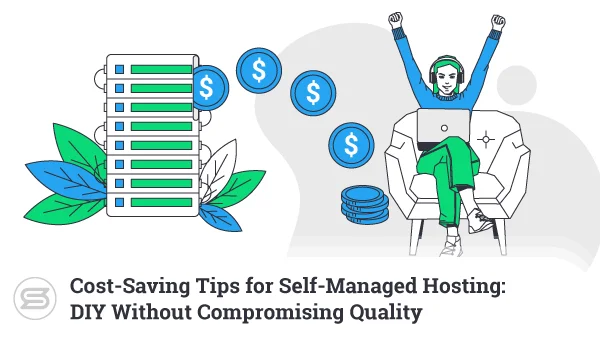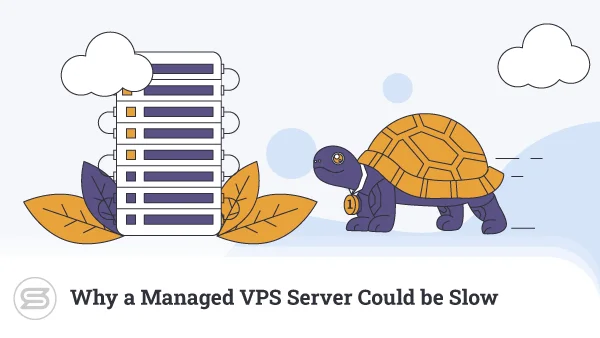The right hosting plan can play a crucial role in your project’s success. The service must be reliable, relatively easy to manage, and, most importantly – it should fit within your budget.
For many, a cPanel VPS is the best combination between performance and usability. But will it break the bank? Let’s find out.
What Is a Web Hosting Control Panel?
Before we get to the nitty-gritty, we need to take a step back, see what cPanel actually is, and figure out how it can help you build your website.
Your hosting account gives you access to a server owned by your hosting provider. The level of access you get depends on the type of hosting you use. Shared plans, for example, give you a relatively limited selection of tools for managing your site files, databases, and emails. With a VPS or a dedicated server, you have much more control over the machine and its system resources.
SSH is one of the ways of managing the account. However, the command-line interface is far from the most beginner-friendly solution, hardly a streamlined approach that suits all.
A web hosting control panel is a management platform that integrates all the tools you need to manage your hosting account into an easy-to-use Graphical User Interface (GUI). Typically accessible through a browser, it features a wide range of utilities required to handle individual projects, create email accounts, upload files, create subdomains, etc.
In short, a control panel makes the hosting service a lot more usable from a novice’s perspective, and it’s a massive time saver for advanced users.
What is cPanel?
Cpanel is one of the most popular web hosting control panels. First introduced in 1996, it now powers tens of millions of websites and a firm favorite with many site and server administrators.
The platform has quite a few advantages. Over the years, cPanel’s developers have improved the design, making the interface as user-friendly as possible.
With its help, you can:
- Install a website building application
- Publish a custom website
- Create and manage email inboxes
- Manage backups
- Configure domains, subdomains, and DNS zones
- Launch databases
- View analytics data and usage statistics
Cpanel hasn’t stopped evolving, with new features being added regularly. Its modular architecture allows hosting providers and resellers to install add-ons and expand the management platform’s functionality. This is possible through WHM (or WebHost Manager) – cPanel’s server management system.
Similar to cPanel, WHM equips you with all the tools you need to manage your server in a user-friendly web-based interface.
WHM helps VPS and dedicated server owners to:
- Set Up individual cPanel accounts
- Manage user quotas and limitations
- Create hosting packages
- Customize the cPanel look and functionality
- Migrate users between different servers
- Blacklist or whitelist IP addresses
- Deploy SSL certificates across the server network
WHM is what resellers use to manage their clients as well. Over the years, the solution has proven its worth as one of the most versatile management platforms of its kind.
But what is the price of this versatility?
Let’s look at how things used to be.
Cpanel’s Cost Over the Years
For years, cPanel and WHM have had a pretty straightforward pricing structure. A monthly charge of $20 per VPS or $45 per dedicated server (discounts applicable) gave everyone the chance to install WHM on a server machine and create as many cPanel accounts as they want.
Thanks to this, shared hosting providers and resellers managed to offer a cost-effective service to their customers. It was also an excellent setup for web development agencies and other businesses that needed to run and maintain multiple projects at once.
In 2019, however, Oakley Capital, the investment firm that had acquired cPanel & WHM just twelve months earlier, decided to implement a new pricing policy. Instead of charging its customers on a per-server basis, it started using the number of cPanel accounts to calculate the licensing fees.
Oakley introduced three new plans:
- Admin – giving you up to 5 cPanel accounts for $20 per month
- Pro – giving you up to 30 cPanel accounts for $30 per month
- Premier – giving you up to 100 cPanel accounts for $45 per month and $0.20 for every additional account over 100
The price difference for cPanel & WHM customers who utilized just a small number of accounts wasn’t that shocking. For larger businesses, however, it was quite significant.
For example, the monthly charge for a dedicated server owner with 200 cPanel accounts went from $45 to $85 overnight, and users with larger projects faced an even bigger price hike.
Thousands of shared hosting providers and resellers had built their business on the old model, and the unexpected rate jump caught them unprepared. The outrage was massive, and Oakley’s response to the criticism did little to ease the minds of those affected by the changes.
The investment firm announced some discounts for large partners and introduced a Solo plan allowing for a single cPanel account. Still, at $15 per month, it’s hardly the most cost-effective control panel solution.
Even with the partnering discounts, cPanel’s new licensing fees meant hosting providers would either need to absorb the losses or move their clients to a different management platform. Quite a few companies opted for the second option.
And what did Oakley Capital do about it?
It increased the prices again…
How Much Does a Typical cPanel VPS Cost at the Moment?
In late-2020 cPanel users were hit with another license fee increase, so if you want to opt-in for the platform today, you should expect to pay around:
- $22/mo for up to 5 cPanel accounts
- $32.25/mo for up to 30 cPanel accounts
- $48.50/mo for up to 100 cPanel accounts and $0.30 for every additional account over 100
Bear in mind that the figures above do not include the price of hosting. Alongside the licensing fees, you’ll also need to have a VPS or a dedicated machine.
Looking around the options, you might be able to find self-managed virtual servers for a few dollars per month. However, we’re talking about bare-boned machines here, not really suited if you don’t know a thing about server management. All the technical work, including the cPanel and WHM installation, falls on your shoulders.
If you need more power or help from your host’s support team – you’ll have to bump up the budget significantly.
cPanel Alternatives
The cost could quickly spiral out of control, especially if you need a powerful virtual machine with multiple projects running on it. Paying it may be even harder to justify, given the numerous alternatives out there.
Let’s have a look at the most notable.
Plesk
Plesk is cPanel’s main competitor in terms of market share, and it’s not difficult to see why. Like cPanel, it presents a wide range of features integrated into, what some argue, an even more intuitive interface. There are Plesk add-ons available for further extending its functionality. Most importantly, the platform is one of the few supporting Windows, serving a broader range of site administrators.
Plesk offers a plan that lets you host an unlimited number of domains on the same server, and pound-for-pound, it’s a much more cost-effective solution for most use-cases. The only thing you need to bear in mind is that, like cPanel, Plesk is owned by Oakley Capital, so unexpected price hikes may surprise you at any time.
DirectAdmin
DirectAdmin is another popular cPanel alternative. It’s a Linux-only panel, renowned for its lightweight, easy-to-use design. Among its features is a clever uptime enhancing system that immediately tries to restart crashed processes. If it fails – the server owner is informed immediately.
Users, resellers, and administrators get their separate dashboards where they find all the tools needed to manage the server and the projects hosted on it.
You have a 60-day trial to try out the panel, and if you like it afterward – you should expect monthly fees between $2 and $29.
Froxlor
Froxlor is another management panel suitable for users, resellers, and server administrators. The lightweight design allows it to run smoothly, even on less powerful hardware. Users looking to have a VPS that’s as cheap as possible will be happy to learn that Froxlor is open-source and completely free to use.
Froxlor may not be as easy-to-get-used-to as some of its competitors, but it’s still equipped with all the features a server administrator needs. The flexible customer and quota management system help resellers run their business more efficiently as well.
Additionally, Froxlor offers advanced SSL configuration, a tool for assigning ports and IP addresses to individual domains, and detailed traffic stats.
ScalaHosting’s Choice – SPanel
In addition to Plesk, DirectAdmin, and Froxlor, you can find dozens of other cPanel alternatives.
At ScalaHosting, however, we believe that to give our users the best possible management platform, we have to build it from scratch. That’s why, over the last few years, we’ve been working on SPanel – an all-in-one proprietary management platform designed specifically for virtual private servers.
Because we built it in-house, we can offer SPanel as a part of our managed VPS solutions at no extra cost to our customers. This enables us to offer fully managed virtual private servers at some of the most competitive prices on the market.
SPanel is compiled of two main parts – an Admin and User interface.
SPanel’s Admin Interface gives you detailed stats on the VPS’s load, memory, and disk usage and lets you:
- Check the server status
- Restart the server or individual services
- Create, Terminate, and Suspend user accounts
- Change user account passwords
- Modify user account quotas
- Configure the Softaculous script installer
Thanks to the re-branding options and the ability to use private nameservers, SPanel is also a brilliant reseller solution.
In SPanel’s User Interface, you can find tools for:
- Setting up email addresses, autoresponders, and forwarders
- Filtering spam
- Managing files
- Handling databases
- Creating subdomains and addon domains
- Managing your domain DNS zones
- Creating and Restoring backups
- Setting up FTP accounts
- Installing CMS software like WordPress
- Editing the php.ini file
- Creating cron jobs
- Changing your PHP version
SPanel is already a pretty versatile management platform, but we want to make it even more powerful. Crucially, we want our customers to be a part of the process. Through a dedicated request platform, our clients can propose new features and vote for ones that have already been suggested.
We’ve already integrated quite a few SPanel tools as a result of user requests, and plenty more are in the pipeline. We believe that this is the best way to steer SPanel’s development in the right direction.
Conclusion
The competition in the web hosting market is fierce, which is good news for the users, as it means providers are constantly trying to come up with ways of keeping the service as lucrative as possible.
Cpanel’s 2019 price hike hasn’t helped in that respect, but fortunately, site admins can find alternatives and set up a budget-friendly VPS with an intuitive and powerful control panel.
FAQ
Q: How much does cPanel cost?
A: The cPanel Solo plan offers WHM installation and a single cPanel account for $15 per month. If you need up to 5 accounts – you can get the Admin plan at $22 per month.
The Pro package costs $32.25 per month and allows up to 30 accounts. With the most expensive Premier plan, you can have up to 100 cPanel accounts for $48.50 per month, and each additional account will cost you $0.30.
Discounts are available for partnering providers.
Q: What do you use cPanel for?
A: Cpanel is a control panel with a graphical user interface that simplifies website and server management. You can use it to publish websites, install software applications, manage files, databases, email and FTP accounts, create subdomains, and many more.
Q: What is WHM?
A: WHM is short for WebHost Manager – cPanel’s server administration platform. Through it, VPS and dedicated server owners can set up and configure cPanel accounts for individual projects. Additionally, they can manage many different aspects of the machine to provide the best possible hosting environment for all sites hosted on it.
ScalaHosting – How Much Does a Typical cPanel VPS Cost?
What is a VPS – Everything you need to know!



